Ruqun
The ruqun (Chinese: 襦裙; Korean: 유군) is a traditional Chinese attire which consists of a short jacket (Chinese: 襦; pinyin: rú) worn under a long skirt (Chinese: 裙; pinyin: qún).[1] However, when use as a general term, ruqun (Chinese: 襦裙) can broadly describe a set of attire which consists of a separated upper garment and a wrap-around lower skirt, or yichang (Chinese: 衣裳; pinyin: yīcháng/yīshang), in which yi (Chinese: 衣) means upper garment, and chang (Chinese: 裳) means lower garment.[2][3]: 27 [4] In a broad sense, ruqun can include shanqun (Chinese: 衫裙) and aoqun (simplified Chinese: 袄裙; traditional Chinese: 襖裙; Korean: 오군) in its definition.[5]: 48–50 [6]: 47–50, 54 [4][7]
| Ruqun | |||||||
|---|---|---|---|---|---|---|---|
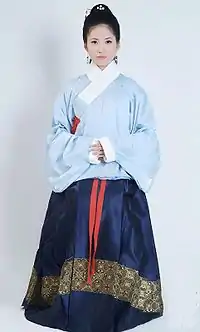 A Chinese lady wearing an aoqun, a style of ruqun popular among Chinese women during the Ming dynasty and Qing dynasty. | |||||||
| Chinese name | |||||||
| Traditional Chinese | 襦裙 | ||||||
| Simplified Chinese | 襦裙 | ||||||
| Literal meaning | Jacket and skirt | ||||||
| |||||||
| Korean name | |||||||
| Hangul | 유군 | ||||||
| Hanja | 襦裙 | ||||||
| |||||||
As a set of attire, the ruqun (襦裙) was worn by both men and women.[2][5]: 48–50 [6]: 47–50, 54 The ruqun was however primarily worn by women,[8] and it is the traditional hanfu for Han Chinese women.[9] The aoqun and/or ruqun is the most basic set of clothing of Han Chinese women in China and has been an established tradition for thousands of years.[6]: 47–50, 54
Terminology
The terminology of ruqun (Chinese: 襦裙) is relatively unstable in both original texts and in secondary sources as different regions may use different terms to describe the same clothing.[5]: 48–50 The ruqun can refer to a specific style of wearing an upper garment called ru (襦; short jacket) under a qun (裙; long skirt).[1] But it can also be used a broad term to refer to a set of attire which consists of a separated upper garment and a skirt (qun; 裙) as lower garment.[2]
The term ru has sometimes been used as a synonym for the clothing items shan (衫) and ao (袄).[5]: 48–50 [10] Ru can also be a short jacket with either short or long sleeves.[11] In addition, the term changru (长襦; lit. long 'ru') also appear in texts and has been described as the precursor of the long-length ao (i.e. long jackets; also known as chang ao) by scholars.[5]: 48–50 Some forms of changru, also known as shuhe (裋褐; i.e. coarse clothing), could reach the knee or the hip level; it was cross-collared closing at the right.[12]
Other terms such as daru (大襦; 'outerwear'), shangru (上襦; 'jackets'),[13] and yiru (衣襦)[11] also exist.
The term ao appears in a Sui dynasty rime dictionary called Qieyun, published in 601 AD and can be translated as "padded coat", but it can also refer to a lined upper garment.[14]: 52
The term shan can also refer to long garments.[10] A form of shan which appeared in the Han and Wei period was a new type of gown which had equal front pieces which were straight instead of cross-collared and was fastened with a string; it was also a form of unlined upper garment with straight sleeves and wide cuffs.[15] This shan was worn by men and women and became popular as it was more convenient for wearing.[15]
The term aoqun (袄裙) typically refers to a specific way of wearing the ao (袄) on top of the lower garment.[1] The Xinhua Dictionary defines ao as a general term referring to an "upper garment with multiple layers". As such, it is a thick piece of clothing worn mostly during cold seasons. Usually, the ao is worn outside of the lower garment, which is often a skirt or mamian.[16]
The term shanqun (衫裙) is a type of clothing style that wears the shan (衫) over the lower garment. The Xinhua Dictionary defines shan as a general term referring to an "upper garment with a single layer". Historically, shan comes in as varying styles, shapes and lengths, and is usually worn outside of the lower garment. However, there are also cases when the shan is worn under the lower garment, as during the Jin dynasty.[16] The Jin dynasty book Gujinzhu (《古今注》) states that women had been wearing one-piece clothing that has the upper and lower garments connected together since the time of the Yellow Emperor, until the Qin dynasty, when shan was invented. In addition, the term shanqun is sometimes used interchangeably with ruqun to refer to short upper garment worn on skirt.[7]
The term yichang (衣裳), also sometimes spelled yishang, is a general term referring to any style of clothing consisted of a pair of upper and lower garments; a yi (衣; a type of upper garment) and a chang (裳) which is a lower garment which can either a skirt or trousers.[6]: 47–50, 54 The term yi can also be a generic term for clothing.[11]
Ruqun, aoqun, and shanqun all belong to the category of yichang. Yichang is not only used to describe specific types of traditional Chinese clothing, but also modern western clothing styles consisted of separate top and bottom garments as well.
 An illustration of a shan (衫) from the Qing dynasty imperial encyclopedia Gujin Tushu Jicheng.
An illustration of a shan (衫) from the Qing dynasty imperial encyclopedia Gujin Tushu Jicheng. Illustration of Qing yiqun (青衣裙) from Gujin Tushu Jicheng.
Illustration of Qing yiqun (青衣裙) from Gujin Tushu Jicheng. Modern illustration of two traditional forms of ruqun (襦裙), a type of Han Chinese clothing worn primarily by women.
Modern illustration of two traditional forms of ruqun (襦裙), a type of Han Chinese clothing worn primarily by women.
Cultural significance
Heaven and Earth symbolism
In traditional Chinese culture, the symbolism of two-pieces garments hold great importance as it symbolizes the greater order of Heaven and Earth;[3]: 12 in the I-Ching, upper garment represents Heaven (Qian) while the lower garment represents the Earth (Kun).[17] It is also why the mianfu (and the yichang in the Iching) has a black upper garment and typically a red (or yellow[18]: 15 [19]) lower garment which symbolized the order between Heaven and earth and should never be confused.[20] According to the Wuxing, black symbolized the colour of the sky (which were dark before dawn[18]: 15 ) while yellow represents the earth.[19]
The order between Heaven and Earth can also translate into clothing length differences between men and women. For example, in 1537, Huo Tao (a Ming dynasty Minister of Rites) expressed, "Men's and women's styles differ in length. A woman's upper garment is level with her waist, her lower garment meets with the top: earth supports heaven. A man's upper garment covers his lower garments: heaven embraces earth. When a woman's [upper] garment covers her lower garments, there is confusion between male and female" in an attempt to reverse the trend in the late Ming when women clothing was gradually getting longer.[5]: 51
The silhouette of yichang can also be made into shàngjiǎn xiàfēng (Chinese: 上俭下丰; lit. 'top is frugal, bottom is rich'),[21] which looks like an A-line silhouette. Shàngjiǎn xiàfēng was a trend in the Wei, Jin, Northern, Southern dynasties.[22][23] However, during the Ming dynasty, shàngjiǎn xiàfēng (Chinese: 上俭下丰; lit. 'top is frugal, bottom is rich') silhouette created with the use of maweiqun (a crinoline-like undergarment for men) reflected an inversion of Heaven and Earth as this form of clothing silhouette contradicts the traditional Chinese principle of Heaven and Earth order.[21] The Shuyuan zaji (椒园杂记) refer to the maweiqun as being fuyao (服妖); the maweiqun was eventually banned in the early Hongzhi era (1487-1505) according to Lu Rong.[24]
Fuyao is a general term with negative connotation which is employed for what is considered as being strange clothing style,[25] or for deviant dressing styles,[26] or for aberrance in clothing.[26] Clothing considered as fuyao typically (i) violates ritual norms and clothing regulations, (ii) are extravagant and luxurious form of clothing, (iii) violates the yin and yang principle, and (iv) are strange and inauspicious form of clothing.[25]
History
As a set of attired consisting of an upper garment and a skirt; the ruqun is the eldest type of hanfu.[27] The Ten Wings in the Book of Changes claims that it was worn by Three Sovereigns and Five Emperors: the legendary Yellow Emperor, Emperor Shun and Emperor Yao, in the form of yichang (衣裳).[28][29]
- "Hence it was that these (sovereigns) were helped by Heaven; they had good fortune, and their every movement was advantageous. Huang Di, Yao, and Shun (simply) wore their [yichang (衣裳)] (as patterns to the people), and good order was secured all under heaven."[29]
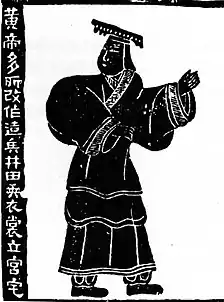 A portrait of Huangdi, the Yellow Emperor, painting Han dynasty.
A portrait of Huangdi, the Yellow Emperor, painting Han dynasty.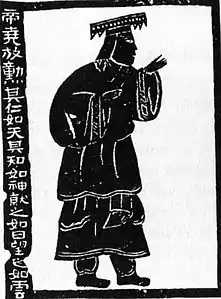 A portrait of Emperor Yao, painting Han dynasty.
A portrait of Emperor Yao, painting Han dynasty.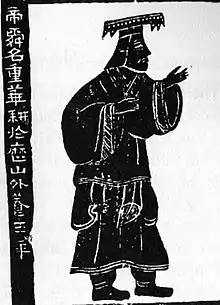 A portrait of Emperor Shun, Han dynasty painting.
A portrait of Emperor Shun, Han dynasty painting.
Shang dynasty
In Shang dynasty, the basic form of clothing was established as the combination of upper and lower garment;[27][18]: 15 this was known as yichang (衣裳).[6]: 47–50, 54 [30] The chang (裳) consisted of a narrow, ankle-length skirt, and upper garment called yi (衣) was a narrow-cuffed, knee-length tunic which was tied with a sash.[31][32][33]: 14–22 The yi could be cross-collared,[30] and it was worn over the chang.[33]: 22 The yichang was a unisex garment.[33]: 14–22
 Statuette of a Standing Dignitary, China, Shang dynasty, Arthur M. Sackler Museum, Harvard University.
Statuette of a Standing Dignitary, China, Shang dynasty, Arthur M. Sackler Museum, Harvard University.
Zhou dynasty, Spring and Autumn Period, and Warring States Period
The Zhou dynasty, people continued to wear yichang, similar to the Shang dynasty; however the Zhou-dynasty style yichang was slightly looser and the sleeves could either be broad or narrow.[34] The yi was cross-collared; it was tied to the right and a sash was used around the waist to tie it closed.[34] The skirt, chang, could vary from knee to ground length.[34] In Zhou dynasty, men also wore short skirts similar to a kilt.[35]
In the Western Zhou dynasty, it was popular to wear ruqun (i.e. jacket with skirt).[36]: 139 [37] Ruqun (jacket with skirt) was also worn by men and women during the Warring States period.[38]: 4 Elites women in the Warring States period also wore a blouse or a jacket, which was fastened to the right to form a V-shaped collar and was waist-length, along with a long full skirt.[14]: 51 The women's blouse tended to have relatively straight and narrow sleeves.[14]: 51 During the Warring States Period and the Spring and Autumn period, a new form of clothing emerged called shenyi, which combined the upper and lower garment into a one-piece robe.
.jpg.webp) Man wearing shanqun (or ruqun) featured in the bronze armed warrior holding up chime bells.
Man wearing shanqun (or ruqun) featured in the bronze armed warrior holding up chime bells. Pair of shamans or attendants, Chu culture, Warring States period, 4th-3rd century BC, Portland Art Museum, Oregon.
Pair of shamans or attendants, Chu culture, Warring States period, 4th-3rd century BC, Portland Art Museum, Oregon.
Qin and Han dynasty
Even though the clothing of the Warring states period were old, they continued to be worn in Qin and Han dynasties, this included the wearing of cross-collared blouse and skirts.[14]: 51
Ruqun (i.e. the combination of blouse and skirts) was worn during by elite women and ordinary women.[14]: 51 Ordinary women during the Han dynasty was wearing ruqun (jackets under skirts) which came in various colours throughout the year.[38]: 4 Ordinary women wore plainer form of ruqun; the skirts were typically plained but the sash which was worn around the waist was decorated.[14]: 51
During the Qin and Han dynasties, women wore skirts which was composed of four pieces cloth sewn together; a belt was often attached to the skirt, but the use of a separate belt was sometimes used by women.[39] The popularity of the jacket and skirt combination briefly declined after the fall of the Eastern Han dynasty, but returned into fashion in the Jin and Northern Wei dynasties and continued to be worn until the Qing dynasty.[14]: 51
 A noble lady figure, Western Han dynasty, 206 B.C.-A.D. 25.
A noble lady figure, Western Han dynasty, 206 B.C.-A.D. 25. A Han Dynasty painting illustrates women wearing ruqun, with blouses tucked into skirts
A Han Dynasty painting illustrates women wearing ruqun, with blouses tucked into skirts A woman in ruqun, i.e. a black cross-collar upper garment tucked inside a red skirt, Dahuting Eastern Han Tombs Mural.
A woman in ruqun, i.e. a black cross-collar upper garment tucked inside a red skirt, Dahuting Eastern Han Tombs Mural. Thin silk skirt, unearthed form Mawangdui Tomb, Han dynasty.
Thin silk skirt, unearthed form Mawangdui Tomb, Han dynasty..jpg.webp) Mawangdui Han Skirt
Mawangdui Han Skirt
Wei, Jin, Northern and Southern dynasties
The women ruqun was popular during the Wei, Jin, Southern and Northern Dynasties.[40][41]: 312–313 In the early Six dynasties period, women wore ruqun (i.e. cross-collared jacket and long skirt) and the jacket of the commoner women was longer than commoner's men.[41]: 312–313 Elite women in the Wei and Jin dynasty wore the combination of wide-cuffed, V-shaped, unlined blouse which was made of pattern fabric and was lined at the neck with a decorative strip of cloth, a long skirt which came in different styles, and apron.[14]: 52 Shàngjiǎn xiàfēng (Chinese: 上俭下丰; lit. 'top is frugal, bottom is rich'; similar to A-line silhouette) was a trend in the Wei, Jin, Northern, Southern dynasties, where skirts large and loose giving an elegant and unrestrained effect.[22][23]
In the Wei Dynasty and Jin Dynasty, women started to wear much longer upper garments which needed to be put out of the skirt in a style called shanqun (衫裙). The shanqun (衫裙) co-existed with the ruqun (i.e. jacket under skirt).
At Luoyang during the Northern Wei dynasty, several variety of clothing styles found on female tomb figures were largely derived from the traditional ruqun (i.e. jacket and skirt) style.[41]: 321–323 One style of ruqun was the combination of short jacket (usually belted and tied at the front of the jacket) with wide sleeves which falls to the knee or below knee level with a very high waist, pleated and multicoloured long skirt.[41]: 321–323 Based on a female tomb figure dating from the Eastern Wei, this form of ruqun is jacket worn over skirt.[41]: 321–323 A popular form of ruqun was the jacket worn under skirt.[41]: 321–323
However, in the early Six dynasties, most ordinary men did not wear ruqun anymore; men, instead wore trousers under their cross-collared jacket (i.e. shanku).[41]: 321–323 The men's jacket were either hip-length or knee-length.[41]: 321–323 The jackets can be tied with a belt or with other forms of closure.[41]: 321–323
 Women wearing ruqun (middle and right), Three Kingdoms.
Women wearing ruqun (middle and right), Three Kingdoms. On the left, a woman wearing ruqun, Three Kingdoms (220-280 AD).
On the left, a woman wearing ruqun, Three Kingdoms (220-280 AD). Western Jin Pottery Female Figure.
Western Jin Pottery Female Figure.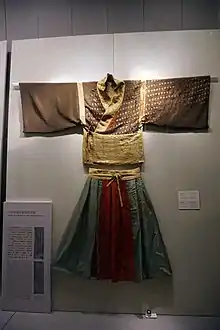
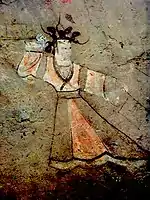

 Women wearing ruqun, Northern Qi.
Women wearing ruqun, Northern Qi.

Sui and Tang dynasties
In the Sui dynasty, ordinary men did not wear skirts anymore.[42] During the Sui and Tang Dynasty, women wore the traditional ruqun wherein the skirts were tied higher and higher up the waist, until they were eventually tied above the breasts, worn with short upper garment.[3]: 1 [38]: 5 This form of style of ruqun is dubbed qixiong ruqun.
In the late sixth century, women's skirts in the Sui dynasty were characterized with high waistline; this kind of high waistline skirt created a silhouette which looked similar to the Empire dresses of Napoleonic France; however, the construction of the assemble differed from the ones worn in Western countries as Han Chinese women assemble consisted of a separate skirt and upper garment which show low décolletage.[43] This trend continued in the early decades of the Tang when women continued the tend of the Sui and would also wear long, high-waisted skirt, low-cut upper garment.[43]
In addition to the normal crossed collar blouses, parallel/straight collar blouses were also worn in this period, thus exposing the cleavage of the breasts. Some Tang dynasty women skirts had accordion pleats.[44] Red coloured skirts were popular.[38]: 5 There was also a skirt called "Pomegranate skirt" for its red colour, and another skirt called "Turmeric skirt" for its yellow colour.[44]
By the Mid-Tang (around the 8th century), the low cleavage upper garment fell out of fashion; the female beauty ideology changed favouring plump and voluptuous beauty.[43]
 Woman in qixiong ruqun, Sui dynasty.
Woman in qixiong ruqun, Sui dynasty.
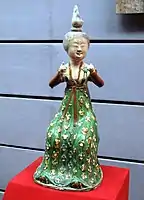
_by_Emperor_Huizong.jpg.webp) A Tang Dynasty painting illustrates women wearing ruqun, with skirts tied above the breasts and short parallel-collar blouses
A Tang Dynasty painting illustrates women wearing ruqun, with skirts tied above the breasts and short parallel-collar blouses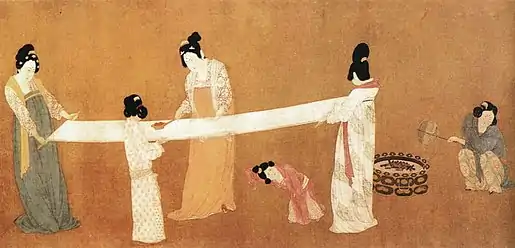 Another Tang Dynasty painting illustrating ruqun
Another Tang Dynasty painting illustrating ruqun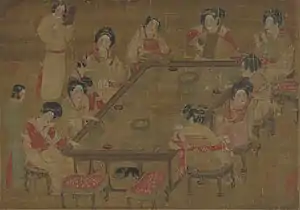 A Tang Dynasty palace concert wearing ruqun
A Tang Dynasty palace concert wearing ruqun
_Liaoning_Provincial_Museum%252C_Shenyang..jpg.webp)
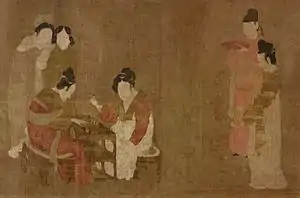
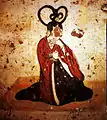
Song, Liao, Western Xia, Jin, and Yuan dynasties
Women continued to wear the Tang dynasty's fashion of wearing the upper garment and skirts tied around their breasts until the Song Dynasty.[45]
In the Song dynasty, the women's skirts were also lowered from the breast level back to the normal waistline.[45] Pleated skirts were introduced and became the main feature of the upper class women.[38]: 5 Song-style ruqun for women consisted of long narrow skirts and jackets which closes to the right.[46] These jackets could be worn over the narrow skirts; this form of ruqun existed in both the Liao dynasty and Song.[46] Cross-collared jackets with narrow sleeves could also be worn under a waist-length skirt or under high waisted-skirt.[47]: 9, 11, 14–16
In Liao dynasty, the Song-style and the Tang-style clothing (including qixiong ruqun) coexisted together; both Khitan women and Han Chinese women in the Liao wore the Han Chinese style Tang-Song dress.[48]: 74–75 [46] Tang-Song style clothing women clothing in Liao also included a long-sleeved, outer jacket with ample sleeves which could cropped or waist-length, was tied with sash in a bow below the breasts to create an empire silhouette.[48]: 74–75 The outer jacket could also be worn over floor-length dress which was worn a short overskirt (which looked like an apron) on top.[48]: 74–75 In Northern Liao mural tomb depictions, women who are dressed in Han style clothing are depicted in Tang dynasty fashion whereas in the Southern Liao murals, women dressed in Han style clothing are wearing Song-style clothing.[46]
In the Yuan dynasty, the Mongols never imposed Mongol customs on the ethnic Han,[49] and they did not force the Han Chinese to wear Mongol clothing.[48]: 84–86 Many Han Chinese and other ethnicities readily adopted Mongol clothing in Northern China to show their allegiance to the Yuan rulers; however, in Southern China, Mongol clothing was rarely seen as both men and women continued to dress in Song-style garments.[50]: 82–83 [48]: 84–86 Tang-Song style clothing also continued to be worn in multiple layers by families who showed that they were resisting the rule of the Mongols.[48]: 84–86 The Song style dress also continued to persist among the southern elites of the Yuan dynasty and evidence of Song-style clothing was also found in the unearthed tombs in southern China.[48]: 84–86 The casual clothing for men mainly followed the dress code of the Han people and they wore banbi as a casual clothing item while ordinary women clothing consisted of banbi and ruqun.[51] Chinese women also wore cross-collar upper garment which had elbow length sleeves (i.e. cross-collar banbi) over a long-sleeved blouse under a skirt; the abbreviated wrap skirts were also popular in Yuan.[47]: 19–20 The way of wearing short-length cross-collar upper garment over long narrow skirt was also a Song-style fashion.[46] Long cross-collar upper garment (about the knee-length) over a long skirt could also be worn by Chinese elite women.[47]: 19–20 Women jackets closing to the right and closing to the left coexisted in the Yuan dynasty. It was also common for Chinese women in the Yuan dynasty to close their clothing to the left side (instead of the right side).[52]
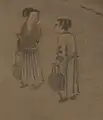 Commoner women wearing ruqun, Song dynasty.
Commoner women wearing ruqun, Song dynasty. Sculpture of maids wearing ruqun, Song dynasty.
Sculpture of maids wearing ruqun, Song dynasty. Women possibly wearing shanqun (upper garment over skirt) and beizi (Song-style clothing), inner chamber of the Tomb of Zhang Kuangzheng, Liao dynasty.
Women possibly wearing shanqun (upper garment over skirt) and beizi (Song-style clothing), inner chamber of the Tomb of Zhang Kuangzheng, Liao dynasty..jpg.webp) Khitan women wearing Tang-style clothing; Baoshan tomb No.2 wall-painting of Liao dynasty.
Khitan women wearing Tang-style clothing; Baoshan tomb No.2 wall-painting of Liao dynasty..jpg.webp) Figure of a Woman Jin-Yuan dynasty China 13th-14th century.
Figure of a Woman Jin-Yuan dynasty China 13th-14th century. Ruqun and banbi, Yuan dynasty. The jacket is closing to the left which is a common style for Chinese women in the Yuan dynasty.
Ruqun and banbi, Yuan dynasty. The jacket is closing to the left which is a common style for Chinese women in the Yuan dynasty.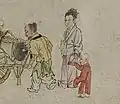 Woman wearing shanqun, Yuan dynasty.
Woman wearing shanqun, Yuan dynasty.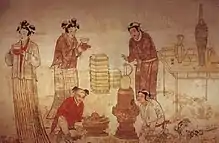 Khitan women wearing Song style ruqun.
Khitan women wearing Song style ruqun. Women depicted in the Fresco in the Hall of King Mingying. Han women wore elbow-length sleeves, cross-collar upper garment over a long-sleeved blouse; the abbreviated skirts were popular in Yuan.[53]
Women depicted in the Fresco in the Hall of King Mingying. Han women wore elbow-length sleeves, cross-collar upper garment over a long-sleeved blouse; the abbreviated skirts were popular in Yuan.[53] Women wearing Song-style ruqun (jacket over skirt) in the Yuan dynasty, from the painting Street Scenes in Times of Peace (Chinese: 太平風會圖), Yuan dynasty 14th century.
Women wearing Song-style ruqun (jacket over skirt) in the Yuan dynasty, from the painting Street Scenes in Times of Peace (Chinese: 太平風會圖), Yuan dynasty 14th century.
Ming dynasty
In terms of appearance, the Ming dynasty ruqun (i.e. the short jacket and skirt) was similar to the Song dynasty's ruqun.[44] Compared to the ruqun worn in the Tang dynasty, the Ming dynasty ruqun was more gentle and elegant; it was also less lavish and yet less rigid and strict as the ruqun worn in the Song dynasty.[3]: 42 One difference from the Song dynasty ruqun is the addition of a small short waist skirt which was worn by young maidservants; it is assumed that it was worn as an apron to protect the long skirt under it.[3]: 42 The short overskirt was called yaoqun.[5]: 48–50 Moreover, following the Yuan dynasty, the style of closing the jacket to the left in women's clothing persisted in some areas of the Ming dynasty, for at least Chinese women who lived in the province of Shanxi.[52] Ming dynasty portrait paintings showing Chinese women dressing in left lapel jackets appeared to be characteristic of ancestral portraits from the province of Shanxi and most likely in the areas neighbouring the province.[52]
In the early Ming Dynasty, ruqun's variant, shanqun, went through a major change when women stopped using the sash. This new style of ruqun, also called aoqun (袄裙; 襖裙), became popular in the late Ming Dynasty.
By the Ming Dynasty, the ruqun became the most common form of attire for women. The sleeves of the blouse were mostly curved with a narrow sleeve cuff (Chinese: 琵琶袖; lit. 'pipa sleeve'). The collar was of the same colour as the clothing. Often, there was an optional detachable protective huling (Chinese: 護領; lit. 'protect collar') sewn to the collar. The huling can be white or any dark colour, and is used to protect the collar from being rotten by sweat, therefore to extend the life of the clothing. Towards the start of the Qing Dynasty, the skirt was mostly baizhequn (Chinese: 百摺裙; lit. 'hundred pleat skirt') or mamianqun.
By the late Ming dynasty, the aoqun (jacket over skirt) became more prevalent than the ruqun (short jacket under skirt); and the ao became longer in length.[5]: 48–50 By the late Ming dynasty, jackets with high collars started to appear.[5]: 93–94 The standup collar were closed with interlocking buttons made of gold and silver,[54] called zimukou (Chinese: 子母扣).[55] The appearance of interlocking buckle promoted the emergence and the popularity of the standup collar and the Chinese jacket with buttons at the front, and laid the foundation of the use of Chinese knot buckles.[54] In women garments of the Ming dynasty, the standup collar with gold and silver interlocking buckles became one of the most distinctive and popular form of clothing structure; it became commonly used in women's clothing reflecting the conservative concept of Ming women's chastity by keeping their bodies covered and due to the climate changes during the Ming dynasty (i.e. the average temperature was low in China).[54]
 A painting by Ming Dynasty painter Tang Yin illustrating women in ruqun
A painting by Ming Dynasty painter Tang Yin illustrating women in ruqun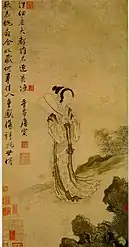 A painting by Ming Dynasty painter Tang Yin illustrating women in ruqun
A painting by Ming Dynasty painter Tang Yin illustrating women in ruqun A painting by Ming Dynasty painter Tang Yin illustrating women in ruqun
A painting by Ming Dynasty painter Tang Yin illustrating women in ruqun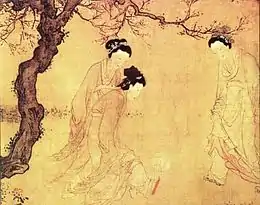 Illustration of Ming Dynasty ruqun
Illustration of Ming Dynasty ruqun A woman (left) wearing an aoqun (i.e. top over skirt), Ming dynasty.
A woman (left) wearing an aoqun (i.e. top over skirt), Ming dynasty.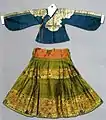 Ming dynasty aoqun.
Ming dynasty aoqun. Aoqun, Ming dynasty.
Aoqun, Ming dynasty.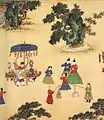 Group of women wearing aoqun, Ming dynasty
Group of women wearing aoqun, Ming dynasty A ming dynasty woman wearing a chang ao over a skirt (possibly a mamian skirt). A blue pifeng is worn over the outfit. The ao jacket is long and has a high stand-up collar.
A ming dynasty woman wearing a chang ao over a skirt (possibly a mamian skirt). A blue pifeng is worn over the outfit. The ao jacket is long and has a high stand-up collar.
Qing dynasty
During the Qing dynasty, the aoqun was the most prominent clothing of Han Chinese women.[5]: 48–50 [56] The ruqun (i.e. short jacket under skirt) continued to be worn in early Qing dynasty,[4] but the later Qing dynasty depictions of ruqun in arts were mostly based on earlier paintings rather than the lived clothing worn by women in this period.[5]: 48–50
In the late Qing, women wore the long jacket ao with the skirt.[57] It was fashionable to wear the ao (袄) with the baizhequn (百摺裙) and the mamianqun.[4] The ao in the Qing dynasty has a front centre closure and then curves crossover to the right before secured with frog buttons.[5]: 48–50 The front closing, collar, hem, and sleeves cuff have edging of contrasting pipings and side slits.[5]: 48–50 The skirts have a flat front and back panels with knife-pleated sides.[5]: 48–50 In Qing, the high collar continued to be used but it was not a common feature in clothing before the 20th century.[5]: 93–94 In the late Qing, the high collar become more popular and was integrated to the jacket and robe of the Chinese and the Manchu becoming a regular garment feature instead of an occasional feature.[5]: 93–94 The high collar remained a defining feature of their jacket even in the first few years of the republic.[5]: 93–94
For the Han Chinese women, the stand-up collar became a defining feature of their long jacket; this long jacket with high collar could be worn over their trousers (shanku) but also over their skirts.[5]: 93–94 In The Chinese and Japanese repository published in 1863 by James Summers, Summers described Chinese women wearing a knee-length upper garment which fits closely at the neck; they wore it together with loose trousers with border around the ankles under a skirt, which opens at the front and has large plaits over the hips. Summers also observed that the sleeves of the women's garment are generally long enough to conceal the hands in cold weather; the sleeves were sometimes very wide and were decorated beautifully with embroidered satin lining which would be turned back to form a border.[58]: 40 In Mesny's Chinese Miscellany written in 1897 by William Mesny, it was observed that skirts were worn by Chinese women over their trousers in some regions of China, but that in most areas, skirts were only used when women would go out for paying visits.[59]: 371 He also observed that the wearing of trousers was a national custom for Chinese women and that trousers were worn in their homes when they would do house chores.[59]: 371 Mesny also observed that men (especially farmers, working men and soldiers) around Shanghai also wore skirts in winter.[59]: 371
Another form of ruqun worn in that period is called qungua (Chinese: 裙褂), which is composed of gua (褂; a jacket with central closure which closes with buttons) worn with a qun (裙) skirt.[60] The gua jacket was a popular form of jacket in Qing and was worn as a summer jacket instead of the ao which was usually worn in winter.[4] The qungua also referred to one style of Qing dynasty wedding dress.[60]
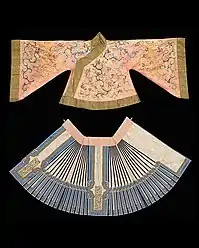
 Illustration of ruqun and pifeng during Qing Dynasty
Illustration of ruqun and pifeng during Qing Dynasty A woman wearing aoqun under a pifeng (aka beizi).
A woman wearing aoqun under a pifeng (aka beizi). Qing dynasty aoqun, the blue ao (jacket) has a slanted/curved opening.
Qing dynasty aoqun, the blue ao (jacket) has a slanted/curved opening. Qing dynasty Han Chinese women wearing Manchu-influenced aoqun and qungua.
Qing dynasty Han Chinese women wearing Manchu-influenced aoqun and qungua. Cantonese Han noble lady with her servants in 1900s wears Manchu-influenced aoqun.
Cantonese Han noble lady with her servants in 1900s wears Manchu-influenced aoqun. Woman's wedding costume from China, an aoqun. c. 1900.
Woman's wedding costume from China, an aoqun. c. 1900. A bride wearing aoqun,
A bride wearing aoqun,
Wenming xinzhuang
In the early 1910s and 1920's, young women wore aoqun called Wenming xinzhuang (文明新裝), also known as the "civilized costume" or "civilized attire".[6]: 47–50, 54 [61][62] It originated from the traditional yishang (衣裳) and the basic style of this clothing is clearly inherited from ancient Han Chinese clothing although the details have changed over time.[6]: 47–50, 54 The Wenming xinzhuang continued the unbroken tradition of Han Chinese women's matching a jacket with a skirt which has been established for thousand of years.[6]: 47–50, 54
The ao of the Wenming xinzhuang was typically cyan and blue in colour while the long skirt was dark in colour, mostly in black; the ao had no complex ornaments as bindings and embroidery was rejected in this period.[6]: 47–50, 54 There was a narrow trim which would bind the hem and the side vents were rectangular in shape.[6]: 47–50, 54 The ao typically had a standing collar and long in shape with its hemline typically reaching below hip height and sometimes even at knee-height.[6]: 47–50, 54 The sleeves were short and left the wrist exposed.[6]: 47–50, 54 The skirt was derived from the baizhequn (百摺裙) and became a dark long skirt with larger pleats.[6]: 47–50, 54 With time, the skirt length eventually shortened to the point where the calves of the wearer was exposed, and the ao had a lower collar and an arc shaped vents started to appear on both sides.[6]: 47–50, 54 This style of clothing eventually faded in the early 1930s.[6]: 47–50, 54
 Aoqun, 1920.
Aoqun, 1920. Aoqun, 1930s
Aoqun, 1930s
21st Century: Modern hanfu
In the 21st Century, several forms of ruqun, whose design are often based on the previous dynasties traditional ruqun but with modern aesthetics, gained popularity following the Hanfu movement.[63][64]
.jpg.webp) Men and women wearing different style of modern ruqun.
Men and women wearing different style of modern ruqun. Ruqun sold in clothing store, 2018.
Ruqun sold in clothing store, 2018._at_IDO32_(20200118144012).jpg.webp) Modern qixiong ruqun.
Modern qixiong ruqun. Modern Ming dynasty aoqun
Modern Ming dynasty aoqun
Construction and Design
As a set of garments, the ruqun consists of an upper and lower garment.
The ruqun can be categorized into types based on the waist height of the skirt:
- Mid-rise (齊腰; qíyāo),
- High-rise (高腰; gāoyāo) and
- Qixiong ruqun (齐胸襦裙; qíxiōngrúqún).
The ruqun can also be categorized based on the collar style. The collar style of the upper garment can be divided into:
- crossed collar (交領; jiāolǐng),
- parallel collar (對襟; duìjīn), also known as straight collar (直领; Zhiling).
| Component | Romanization | Hanzi | Definition |
|---|---|---|---|
| Upper garment | Yi | 衣 | Open cross-collar upper garment, or refers to any form upper garment.[30] It is unisex.[9] |
| Ru | 襦 | Open cross-collar upper garment,[34] only worn by women.
It typically refers to a short jacket.[5]: 48–50 [3]: 27 It is usually waist-length, but longer forms of ru can also be found.[5]: 48–50 The ru can be single-layered or multi-layered (i.e. double layered or padded).[65][3]: 27 | |
| Changru | 长襦 | A long ru jacket; the precursor of the long ao.[5]: 48–50 | |
| Ao | 袄 | Multi-layer open cross-collar shirt or jacket.[30] It was mainly worn as winter clothing.[30][4] | |
| Shan | 衫 | Lit. translated as "shirt".[41]: 325 Single-layer open cross-collar shirt or jacket.[65][34] It can also be worn over the yi (衣).[34] | |
| Changao | 長襖 | A longer version of the ao | |
| Gua | 褂 | A jacket with a central closure which closes with buttons.[60] They appeared to be made of thinner fabric than the ao and was worn in summer.[4] It was worn as a female wedding jacket.[60] | |
| Lower garment | Chang/shang | 裳 | Skirt for men,[34] or may refers to any form of lower garment including skirts and trousers.[6]: 47–50, 54 In the Shang dynasty, the chang could also refer to an ankle-length skirt which was a unisex garment. |
| Qun | 裙 | Skirt for women.[34] |
Women's skirts
Throughout history, Han Chinese women wore many kind of skirts which came in variety of styles; some of which had their own specific names.
Types of ruqun
- Mianfu
- Qixiong ruqun
- Qungua (裙褂): a type of ruqun worn as a Traditional Chinese Wedding dress in Qing and in modern era.
- Tanling ruqun: a type of ruqun with a U-shaped upper garment
- Xiuhefu (秀禾服): a type of aoqun worn as a Traditional Chinese Wedding dress in Qing and in modern era.
- Xuanduan (玄端): a very formal dark ruqun with accessories; equivalent to the Western white tie.
References
- Wang, Xinyi; Colbert, François; Legoux, Renaud (2020). "From Niche Interest to Fashion Trend: Hanfu Clothing as a Rising Industry in China". International Journal of Arts Management. 23 (1). Retrieved 1 February 2021.
- Fang, Zhou (2019). "On the Differences between the "Paofu" and "Ruqun" Types of Men's Costumes in the Cave Murals of Dunhuang--《Dunhuang Research》2019年05期". en.cnki.com.cn. Retrieved 2021-03-12.
{{cite web}}: CS1 maint: url-status (link) - Hua, Mei (2011). Chinese clothing (Updated ed.). Cambridge, United Kingdom. ISBN 978-0-521-18689-6. OCLC 781020660.
- Wang, Anita Xiaoming (2018). "The Idealised Lives of Women: Visions of Beauty in Chinese Popular Prints of the Qing Dynasty". Arts Asiatiques. 73: 61–80. doi:10.3406/arasi.2018.1993. ISSN 0004-3958. JSTOR 26585538.
- Finnane, Antonia (2008). Changing clothes in China : fashion, history, nation. New York: Columbia University Press. ISBN 978-0-231-14350-9. OCLC 84903948.
- Styling Shanghai. Christopher Breward, Juliette MacDonald. London. 2020. ISBN 978-1-350-05116-4. OCLC 1124593626.
{{cite book}}: CS1 maint: others (link) - "The Most Classic Hanfu of All Time - 2021". www.newhanfu.com. 2020. Retrieved 2021-04-10.
{{cite web}}: CS1 maint: url-status (link) - Birmingham Museum of Art. "QUICK GUIDE TO HAN DYNASTY CLOTHING". www.artsbma.org. Retrieved 2021-04-10.
{{cite web}}: CS1 maint: url-status (link) - Zeng, Yao (2011). "Chinese influence on western women's dress in American Vogue magazine, 1960-2009". LSU Doctoral Dissertations: 21.
- Li, Shizhen (2021). Ben cao gang mu : 16th century Chinese encyclopedia of materia medica and natural history : the complete Chinese text. Paul U. Unschuld. Oakland, California: Univ of California Press, 2021. p. 65. ISBN 978-0-520-37989-3. OCLC 1196241770.
- Legal practice in the formative stages of the Chinese empire : an annotated translation of the exemplary Qin criminal cases from the Yuelu Academy collection. Thies Staack, Ulrich Lau, Yuelu shu yuan. Leiden. 2016. p. 219. ISBN 978-90-04-31565-5. OCLC 940958336.
{{cite book}}: CS1 maint: others (link) - Qin shi huang ling bing ma yong keng yi hao keng fa jue bao gao, 1974-1984. Shanxi Sheng kao gu yan jiu suo, Shanxi shi huang ling Qin yong keng kao gu fa jue dui, 陜西省考古研究所, 陜西始皇陵秦俑坑考古发掘队. (Di 1 ban ed.). Beijing: Wen wu chu ban she. 1988. p. 490. ISBN 7-5010-0174-X. OCLC 21157680.
{{cite book}}: CS1 maint: others (link) - Peng, Hao; Zhang, Ling (2018). "On "Skirts" and "Trousers" in the Qin Dynasty Manuscript Making Clothes in the Collection of Peking University". Chinese Cultural Relics. 5 (1): 248–268.
- Howard, Michael C. (2016). Textiles and clothing of Viet Nam : a history. Jefferson, North Carolina. ISBN 978-1-4766-6332-6. OCLC 933520702.
- The University of California (1997). 中國文學 Issues 379-382. Foreign Languages Press. p. 177.
- 管理员. "袄裙和襦裙的区别,可不只是在于名字!". 优旅特. 汉服文化知识. Retrieved 2021-08-30.
{{cite web}}: CS1 maint: url-status (link) - The complete I ching : the definitive translation. Alfred Huang (10th ed.). Rochester, Vt.: Inner Traditions. 2010. ISBN 978-1-59477-886-5. OCLC 725228353.
{{cite book}}: CS1 maint: others (link) - Feng, Ge (2015). Traditional Chinese rites and rituals. Zhengming Du. Newcastle upon Tyne: Cambridge Scholars Publishing. ISBN 978-1-4438-8783-0. OCLC 935642485.
- Min, Jianshu (2006). Chinese leadership wisdom from the Book of Change. Hong Kong: The Chinese University Press. pp. 97–98. ISBN 978-988-237-791-2. OCLC 646952654.
- "Ancient Chinese Royal Ceremonial Wear". english.visitbeijing.com.cn. 2012. Retrieved 2022-02-13.
- 崔晓旋; 玲, 张 (2021). "金明两代"裙撑"文化考议". 服饰导刊 (in Chinese). 10 (4): 10–16.
- Yu, Xianrong (2018). "An Overview of the Development of Chinese Embroidered Clothing in the Past Dynasties". Proceedings of the 2018 International Conference on Sports, Arts, Education and Management Engineering (SAEME 2018). Atlantis Press. pp. 175–180. doi:10.2991/saeme-18.2018.32. ISBN 978-94-6252-539-9.
- "搜神记 : 第七卷 - Chinese Text Project". ctext.org. Retrieved 2022-02-13.
- "菽园杂记 - 中国哲学书电子化计划". ctext.org (in Chinese (China)). Retrieved 2022-02-12.
- Yuan., Zujie (2004). Dressing the state, dressing the society : ritual, morality, and conspicuous consumption in Ming Dynasty China. UMI Dissertation services. pp. 174–175, 187. OCLC 491286822.
- Tian, Xiaofei (2011). Visionary journeys : travel writings from early medieval and nineteenth-century China. Cambridge, Mass. p. 185. ISBN 978-1-68417-062-3. OCLC 956317841.
- Zhao, Yin (2014). Snapshots of Chinese culture. Xinzhi Cai. Los Angeles: Bridge21 Publications. ISBN 978-1-62643-003-7. OCLC 912499249. Archived from the original on 2014.
- . Ten Wings (in Chinese) – via Wikisource.
黃帝、堯、舜垂衣裳而天下治,蓋取諸乾坤。
- "Book of Changes: Xi Ci II - Chinese Text Project". ctext.org. Retrieved 2021-03-12.
{{cite web}}: CS1 maint: url-status (link) - Han, Jiantang (2012). Chinese characters. Cambridge: Cambridge University Press. p. 132. ISBN 978-0-521-18660-5. OCLC 761380349. Archived from the original on 2012.
- Sullivan, Lawrence R. (2021). Historical dictionary of Chinese culture. Nancy Liu-Sullivan. Lanham, Maryland: Rowman & Littlefield. p. 173. ISBN 978-1-5381-4604-0. OCLC 1233321993. Archived from the original on 2021.
- Neo, Jocelyn; Yen, Li (23 December 2018). "Singapore Han Cultural Society: Reviving Chinese Han Couture (Hanfu)". The Epoch Times (Singapore). Retrieved 3 February 2021.
- Lüsted, Marcia Amidon (2017). Ancient Chinese daily life (1 ed.). New York: New York : Rosen Publishing. p. 22. ISBN 978-1-4777-8889-9. OCLC 957525459.
- Ho, Wei; Lee, Eun-young (2009). "Modern Meaning of Han Chinese Clothing" (PDF). Journal of the Korea Fashion & Costume Design Association. 11 (1): 99–109.
- Xu, Zhuoyun (2012). China : a new cultural history. Timothy Danforth Baker, Michael S. Duke. New York: Columbia University Press. p. 166. ISBN 978-0-231-15920-3. OCLC 730906510.
- Wang, Ningning (2019). A history of ancient Chinese music and dance. Zhengshuan Li, Xin Wang, Yundi Gao. Salt Lake City. UT. ISBN 978-1-63181-634-5. OCLC 1285973778.
- Lullo, Sheri A. (September 2019). "Trailing Locks and Flowing Robes: Dimensions of Beauty during China's Han dynasty (206 bc – ad 220)". Costume. 53 (2): 231–255. doi:10.3366/cost.2019.0122. S2CID 204710548. Retrieved 3 February 2021.
- Yang, Shaorong (2004). Traditional Chinese clothing : costumes, adornments & culture (1 ed.). San Francisco: Long River Press. ISBN 1-59265-019-8. OCLC 52775158. Archived from the original on 2004.
- Zang, Yingchun; 臧迎春. (2003). Zhongguo chuan tong fu shi. 李竹润., 王德华., 顾映晨. (Di 1 ban ed.). Beijing: Wu zhou chuan bo chu ban she. ISBN 7-5085-0279-5. OCLC 55895164. Archived from the original on 2003.
- 周方; 服装·艺术设计学院, 东华大学; 周方; 卞向阳; 服装·艺术设计学院,上海200051, 东华大学 (2018-07-02). "罗袿徐转红袖扬 ——关于古代袿衣的几个问题". 丝绸 (2018年 06). ISSN 1001-7003.
- Dien, Albert E. (2007). Six dynasties civilization. New Haven, Conn.: Yale University Press. ISBN 978-0-300-07404-8. OCLC 72868060.
- Ma, Boying (2020). History Of Medicine In Chinese Culture, A (In 2 Volumes). Singapore. p. 40. ISBN 978-981-323-799-5. OCLC 1147841857.
- Steele, Valerie (1999). China chic : East meets West. John S. Major. New Haven: Yale University Press. ISBN 0-300-07930-3. OCLC 40135301.
- Hua, Mei; 华梅 (2004). Zhongguo fu shi (Di 1 ban ed.). Beijing: Wu zhou chuan bo chu ban she. ISBN 7-5085-0540-9. OCLC 60568032.
- Yuan, Zujie (2007). "Dressing for power: Rite, costume, and state authority in Ming Dynasty China". Frontiers of History in China. 2 (2): 181–212. doi:10.1007/s11462-007-0012-x. ISSN 1673-3401. S2CID 195069294.
- SHEA, Eiren L. (2021-12-15). "Intentional Identities: Liao Women's Dress and Cultural and Political Power". Acta Via Serica. 6 (2): 37–60. doi:10.22679/AVS.2021.6.2.003.
- Sun, Ming-ju (2002). Chinese fashions. Mineola, N.Y.: Dover Publications. ISBN 0-486-42053-1. OCLC 55693573.
- Shea, Eiren L. (2020). Mongol court dress, identity formation, and global exchange. New York, NY. ISBN 978-0-429-34065-9. OCLC 1139920835.
- Bulag, Uradyn E. (2010), Wearing Ethnic Identity: Power of Dress, vol. 6, Oxford: Berg Publishers, pp. 75–80, doi:10.2752/bewdf/edch6014, ISBN 9781847888556, retrieved 2021-02-28
- Watt, James C. Y. (2010). The world of Khubilai Khan : Chinese art in the Yuan Dynasty. Maxwell K. Hearn, Metropolitan Museum of Art. New York: Metropolitan Museum of Art. ISBN 978-1-58839-402-6. OCLC 606786260.
- "Costume in the Yuan Dynasty---ASEAN---China Center". www.asean-china-center.org. Retrieved 2021-07-18.
- The Museum of Far Eastern Antiquities Bulletin No.70. Östasiatiska museet. 1998. p. 208.
- Sun, Ming-ju (2002). Chinese fashions. Mineola, N.Y.: Dover Publications. p. 19. ISBN 0-486-42053-1. OCLC 55693573.
- Hao, Xiao’ang; Yin, Zhihong (2020). "Research on Design Aesthetics and Cultural Connotation of Gold and Silver Interlocking Buckle in the Ming Dynasty". Proceedings of the 4th International Conference on Art Studies: Science, Experience, Education (ICASSEE 2020). Paris, France: Atlantis Press. doi:10.2991/assehr.k.200907.030. ISBN 978-94-6239-051-5. S2CID 221756137.
- "Zimu Kou - Exquisite Ming Style Hanfu Button - 2021". www.newhanfu.com. 25 May 2021. Retrieved 2021-12-12.
- Bonds, Alexandra B. (2008). Beijing opera costumes : the visual communication of character and culture. Honolulu: University of Hawaiʻi Press. p. 168. ISBN 978-1-4356-6584-2. OCLC 256864936. Archived from the original on 2008.
- Baghdiantz McCabe, Ina (2015). A history of global consumption : 1500-1800. New York. p. 178. ISBN 978-1-317-65265-6. OCLC 889676602.
- Summers, James (1863). The Chinese and Japanese repository of Facts and Ebents in Science, History, and Art, relating to Easter Asia. Vol. I. Princeton University.
- Mesny, William (1897). Mesny's Chinese Miscellany. China Gazette Office. OCLC 810192986.
- Qiao, Nan; Tan, Yan-rong (2017). "Talk About the Chinese Wedding Dress of Modern Women". 2017 3rd International Conference on Social, Education and Management Engineering (SEME 2017) (seme): 299–301.
- "Bloomsbury Collections - Styling Shanghai". www.bloomsburycollections.com. Retrieved 2021-04-05.
- ""Qipao" of different eras on display at Museum of History (with photos)". www.info.gov.hk. Retrieved 2021-04-05.
- Zhang, Tianwei (2020-11-25). "Putting China's Traditional Hanfu on the World Stage". WWD. Retrieved 2021-06-09.
- YEEN, OH ING. "Laudable aim to revive tradition". The Star. Retrieved 2021-06-09.
- "3 Types of Traditional Chinese Top - 2021". www.newhanfu.com. 2020. Retrieved 2021-03-17.
{{cite web}}: CS1 maint: url-status (link)